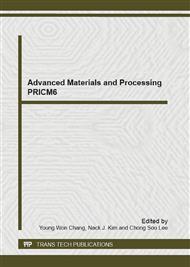p.845
p.849
p.853
p.857
p.861
p.865
p.869
p.873
p.877
Surface Fractals and Wetting Properties of Porous Anodes Strengthened by Ni3Al for Molten Carbonate Fuel Cell
Abstract:
The contact angles of pure Ni, Ni/7wt%Ni3Al, Ni/5wt%Ni3Al/ 5wt%Cr and Ni/10wt%Cr anodes for the MCFC were measured by means of the capillary rise method in 62mol%Li2CO3+ 38mol%K2CO3 and 52mol%Li2CO3+ 48mol% Na2CO3 electrolyte and at different atmosphere. Also surface fractal dimension (Ds), which could characterize pore structure of the anodes, was calculated from experimental data obtained by mercury porosimetry and nitrogen adsorption method. The surface fractal dimensions of the anode were in range from 2.75 to 2.81, because porosities of the anodes for MCFC were controlled regularly to about 62% during sintering. It was investigated from wetting-in experiment by capillary-rise method that the contact angles between the anodes and the carbonate electrolytes were relatively decreased at CO2 atmosphere rather than air atmosphere and the angles were also decreased in the 62mol%Li2CO3+38mol%K2CO3 electrolyte rather than that measured and in the 52mol%Li2CO3+48mol% Na2CO3 electrolyte.
Info:
Periodical:
Pages:
861-864
Citation:
Online since:
October 2007
Authors:
Keywords:
Price:
Сopyright:
© 2007 Trans Tech Publications Ltd. All Rights Reserved
Share:
Citation:


